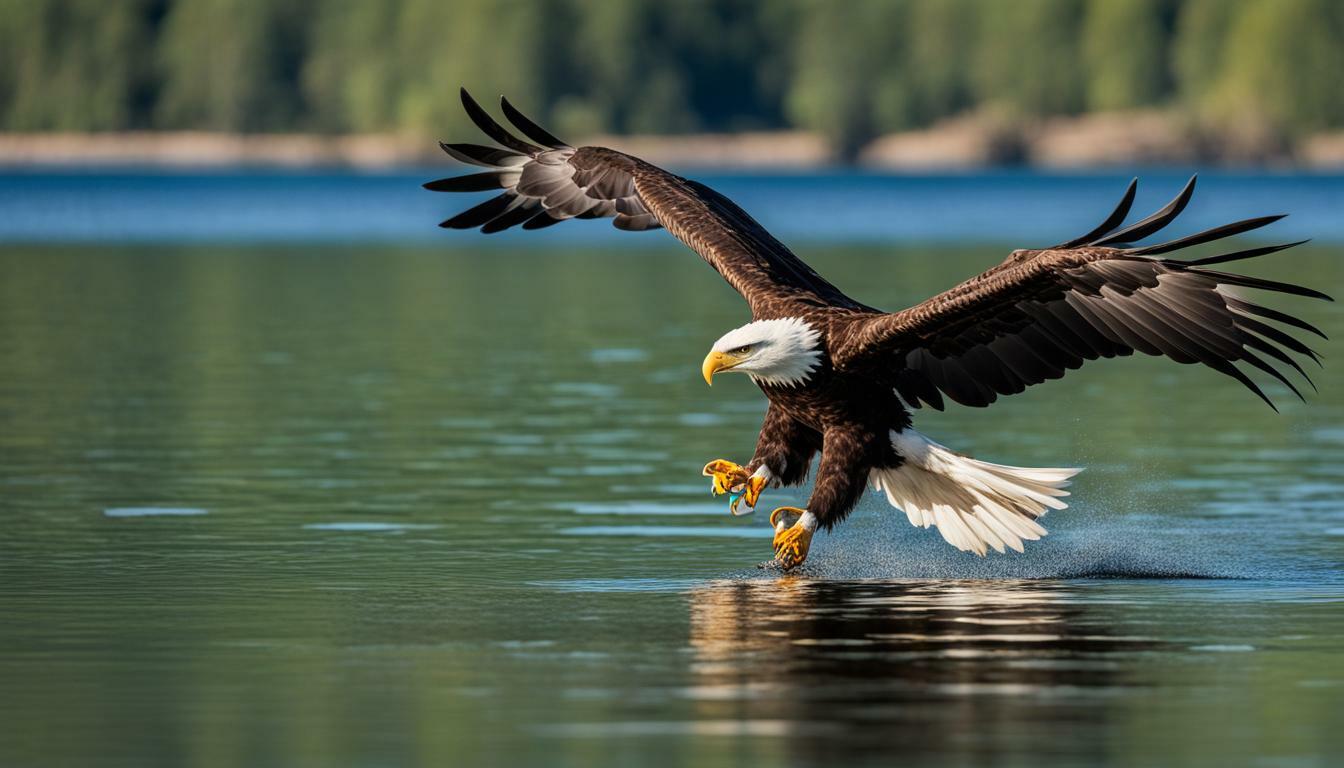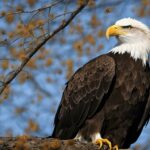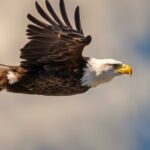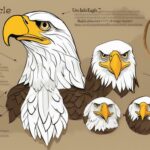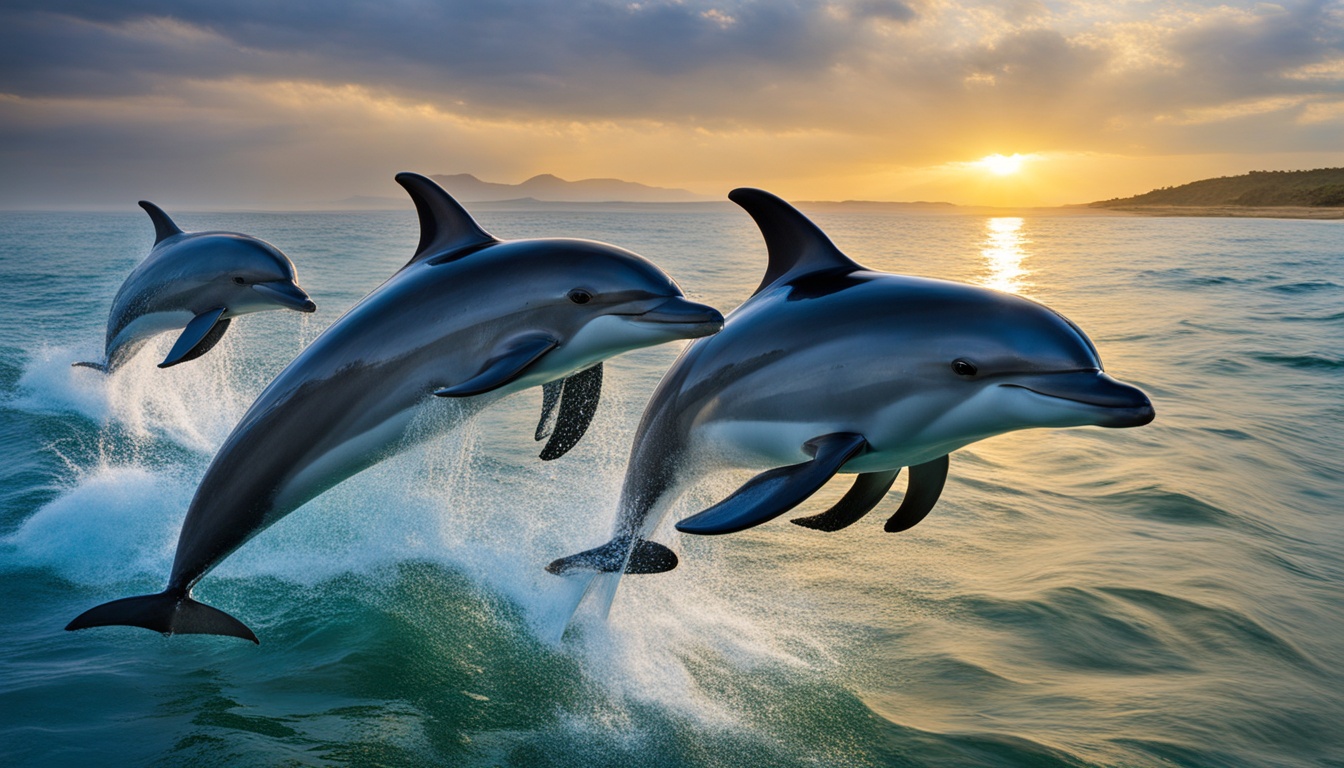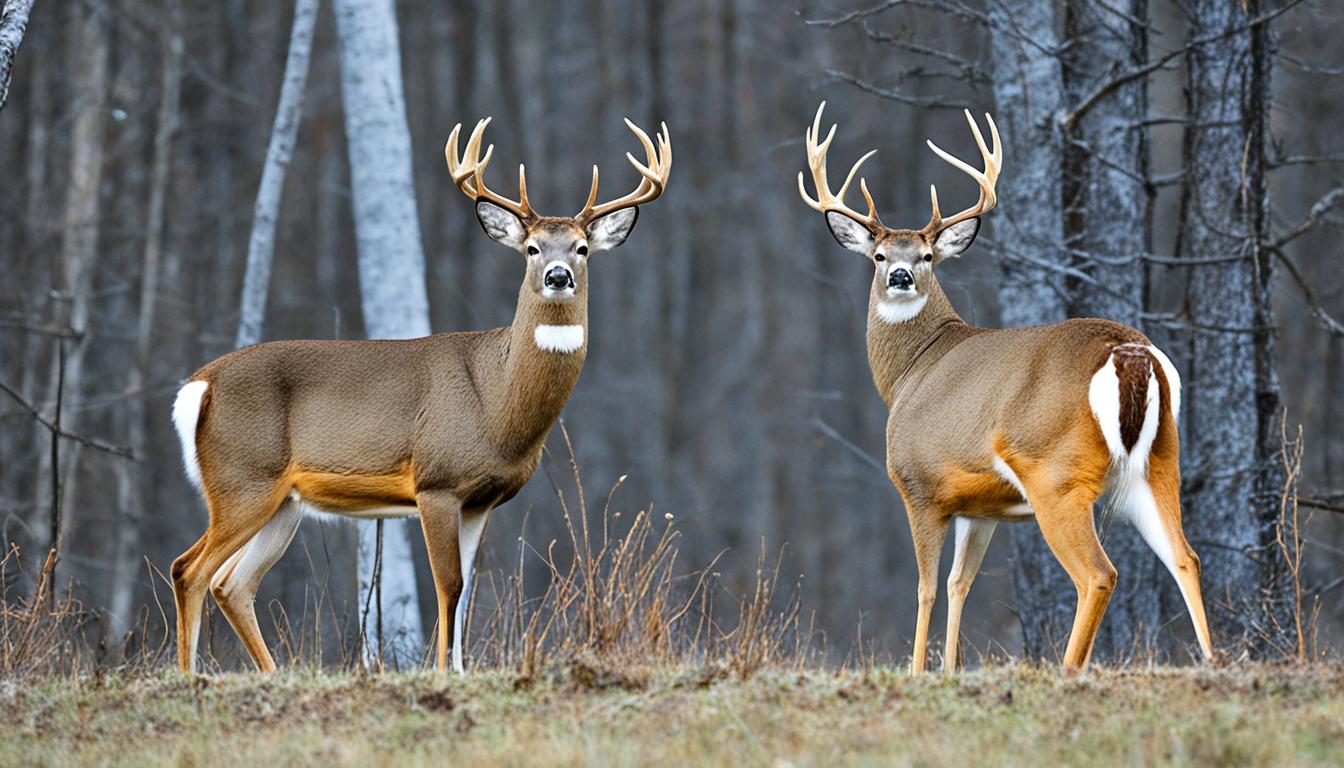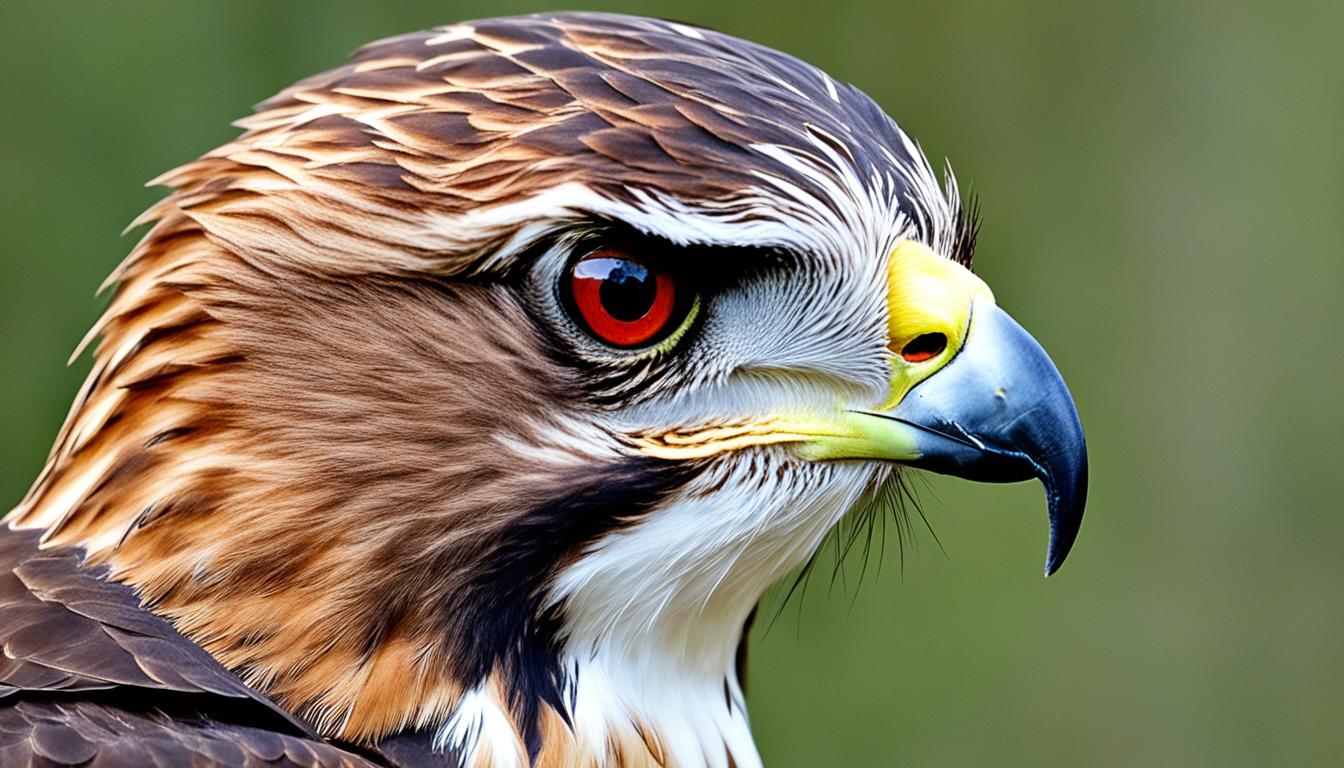Bald eagles are known for their exceptional hunting and soaring abilities, but are they also good swimmers? The answer might surprise you.
While bald eagles are not necessarily known as strong swimmers, they are surprisingly adept at navigating water bodies. In fact, they are known to swim with ease and have even been spotted swimming long distances in pursuit of their prey.
Key Takeaways:
- Bald eagles are not typically known for their swimming abilities, but they are skilled swimmers.
- They have unique adaptations that allow them to navigate water bodies with ease.
- Their affinity for water and swimming abilities make them proficient hunters.
Bald Eagle Adaptations for Swimming
One of the most fascinating aspects of bald eagles is their ability to swim. While they are primarily known for their aerial prowess, bald eagles are quite adept in the water thanks to a number of unique adaptations.
First and foremost, bald eagles are equipped with incredibly strong wings that enable them to swim through the water with ease. Their wings are specifically designed to be used as paddles, helping them to propel themselves through the water and maintain buoyancy. This makes them one of the strongest swimmers among all bird species.
| Adaptation | Description |
|---|---|
| Feather Waterproofing | Bald eagles have a special gland that produces oil that they spread over their feathers to keep them waterproof. This allows them to float more easily and maintain body temperature when in the water. |
| Long and powerful talons | Bald eagles use their talons to grasp onto fish and other prey while swimming. Their talons are long and powerful, allowing them to hold onto larger prey while swimming back to shore. |
| Large and flat feet | Bald eagles have large and flat feet that help them to swim more efficiently. This feature also helps them to maintain balance while in the water. |
Bald eagles also have a number of other adaptations that help them to thrive in aquatic environments. For example, they have specialized nostrils that close when they are submerged, enabling them to hold their breath for extended periods of time while diving for prey. They also have a nictitating membrane, or third eyelid, which protects their eyes while swimming or diving.
Overall, the unique adaptations of bald eagles make them highly proficient swimmers, allowing them to thrive in a variety of environments and habitats.
Bald Eagle Aquatic Skills
When it comes to swimming, bald eagles are quite skilled creatures. In fact, they are known to be one of the best swimming birds out there. Their powerful wings and talons make them proficient hunters both on land and in water.
One of their notable aquatic skills is their ability to navigate water bodies with ease. They are able to swim long distances, diving in and out of the water as they search for prey. They also use their wings to help them propel themselves through the water, flapping them in a way that propels them forward.
Bald eagles are also able to use their wings to “row” themselves through the water. They use their wings to paddle, allowing them to quickly change directions or slow down their swimming speed. This technique is particularly useful when chasing after fast-moving prey.
Another impressive skill that bald eagles possess is their ability to pluck fish out of the water with their talons. They will dive into the water, grabbing their prey with their strong talons before swiftly taking off back into the air. This technique requires great precision and timing, and bald eagles are masters at it.
All in all, bald eagles are incredibly skilled swimmers, utilizing their unique adaptations to thrive in aquatic habitats.
Bald Eagle Hunting Techniques
Bald eagles are apex predators, and their hunting techniques are well-suited to their aquatic habitats. Their primary prey is fish, and they have developed a variety of hunting techniques to catch their meals.
One of the most common hunting techniques used by bald eagles is perching on a high branch or rock and scanning the waters for fish. Once they spot their prey, they will swoop down and grab it with their talons.
Bald eagles also use a technique called “plucking” to catch fish. This involves flying low over the water and using their talons to grab fish just below the surface. They then lift themselves out of the water and carry their prize to a safe place to eat.
Bald eagles have also been observed working together to catch fish. One eagle will distract a school of fish while the other swoops in to grab one.
Overall, bald eagles use a combination of keen eyesight, powerful talons, and excellent aerial maneuverability to catch their prey in the water.
Bald Eagle Wings for Swimming
One of the most unique adaptations of bald eagles for swimming is their wings. While most birds use their wings solely for flying, bald eagles also use them to swim. Their broad and powerful wings act like paddles, propelling them through the water with ease.
In addition, the shape of their wings is optimized for swimming. The broad surface area of their wings allows for maximum push against the water, while their tapered tips reduce drag and allow for efficient movement. This adaptation makes bald eagles incredibly agile swimmers, able to quickly change direction and maneuver through the water.
While their wings are essential for swimming, bald eagles also use their talons to grasp onto prey while in the water. This unique combination of adaptations makes them formidable hunters, able to catch fish and other aquatic prey with precision and skill.
Bald Eagle Habitat and Swimming Requirements
If you’re wondering where to find bald eagles swimming, you’ll need to look for bodies of water that meet their specific habitat requirements. Bald eagles are commonly found near rivers, lakes, and other large bodies of water, where they can easily hunt for fish and other aquatic prey. They prefer habitats with trees near the water, which they use as perches to scan for prey.
In addition to water bodies, bald eagles also require specific environmental conditions to swim comfortably. The water must be deep enough for them to submerge their entire bodies, and the temperature should not be too cold or too warm.
Bald eagles typically swim close to the surface of the water, using their powerful wings to propel themselves forward. They are able to swim with their wings partially extended, which helps them maintain stability and steer in different directions. When swimming longer distances, they alternate between using their wings and their feet to paddle through the water.
Bald Eagles vs Other Aquatic Birds
If you’re wondering how bald eagles fare against other aquatic birds, the answer is quite impressive. While many other birds rely on floating and paddling to move through water, bald eagles use powerful strokes of their wings to propel themselves forward. This unique ability allows them to more efficiently move through the water, making them a formidable swimmer.
In addition, bald eagles have several other adaptations that give them an advantage over other aquatic birds. Their sharp talons are perfectly adapted for catching fish, and their keen eyesight allows them to easily spot prey swimming beneath the surface. These adaptations, combined with their impressive swimming abilities, make them one of the most skilled aquatic birds around.
Bald Eagles’ Love for Water
Did you know that bald eagles have a strong affinity for water? These majestic birds are often found near water bodies, including rivers, lakes, and coastlines.
While bald eagles are proficient fliers and hunters, they also enjoy spending time in the water. They have been known to swim for extended periods, using their wings to propel themselves through the water.
When not swimming, bald eagles can be found perched near water bodies, waiting patiently for their next meal to swim by. They also use these habitats for nesting and raising their young, highlighting the importance of water bodies in their life cycle.
“Bald eagles are often found near water bodies, including rivers, lakes, and coastlines.”
If you ever have the pleasure of observing a bald eagle near water, take note of their behavior. You may see them perched on a rock or tree limb, scanning the water for potential prey. Or, you may witness them swooping down to catch a fish with their talons.
Overall, bald eagles’ love for water is just another amazing aspect of these incredible birds. Their swimming abilities and adaptations make them well-suited to their aquatic habitats, and their connection to water highlights the importance of preserving these environments for future generations to enjoy.
Bald Eagles’ Swimming Abilities: Conclusion
Congratulations! You have made it to the end of the article. So, are bald eagles good swimmers? The answer is a resounding yes! As we have discovered in the previous sections, bald eagles are proficient swimmers, aided by their unique adaptations and behaviors.
Recap of Key Points
Throughout this article, we have explored:
- The swimming abilities of bald eagles
- Bald eagles’ adaptations for swimming
- Bald eagles’ aquatic skills
- Bald eagles’ hunting techniques in relation to their swimming abilities
- The role of bald eagle wings in swimming
- Bald eagles’ habitat and swimming requirements
- Comparison of bald eagles’ swimming abilities to other aquatic birds
- Bald eagles’ love for water
All of these points demonstrate the prowess of bald eagles in the water. Their unique adaptations, including a streamlined body and specially designed feathers, allow them to navigate water bodies with ease. Their ability to use their wings for swimming and their hunting techniques also contribute to their impressive aquatic skills.
Final Thoughts
Although bald eagles are primarily known for their hunting abilities, their swimming skills are equally impressive. Their affinity for water and their ability to thrive in aquatic habitats highlight their adaptability and strength as a species. We hope this article has provided you with a greater appreciation for the amazing abilities of bald eagles when it comes to swimming.
Do Bald Eagles Eat Other Animals Besides Fish?
Bald eagles’ diverse and fish-filled diet is not limited to just fish. These majestic birds are opportunistic predators and will readily devour other animals as well. While fish usually dominate their menu, bald eagles also feed on small mammals, waterfowl, reptiles, and even carrion when available. This dietary flexibility allows them to adapt to various habitats and ensures their survival throughout the year.
FAQ
Q: Are bald eagles good swimmers?
A: Yes, bald eagles are good swimmers. Their unique adaptations and behaviors enable them to navigate through water bodies effectively.
Q: What are some bald eagle adaptations for swimming?
A: Bald eagles have adaptations such as strong wings, long talons, and waterproof feathers that allow them to swim efficiently.
Q: What aquatic skills do bald eagles possess?
A: Bald eagles can navigate water bodies, use their wings for swimming, and employ other techniques while in the water.
Q: How do bald eagles hunt in relation to their swimming abilities?
A: Bald eagles primarily hunt for fish and other aquatic prey in their natural habitats, utilizing their swimming abilities to catch their prey.
Q: How do bald eagle wings aid in their swimming?
A: Bald eagles use their wings to propel themselves through the water and their wing shape enhances their swimming abilities.
Q: What are the habitat requirements of bald eagles in relation to swimming?
A: Bald eagles prefer habitats with water bodies such as lakes and rivers, as these environments support their swimming behaviors.
Q: How do bald eagles compare to other aquatic birds in terms of swimming abilities?
A: Bald eagles have unique adaptations that set them apart from other aquatic birds and make them proficient swimmers.
Q: What is the connection between bald eagles and water?
A: Bald eagles have a strong affinity for water and exhibit behaviors that showcase their love for aquatic habitats.

